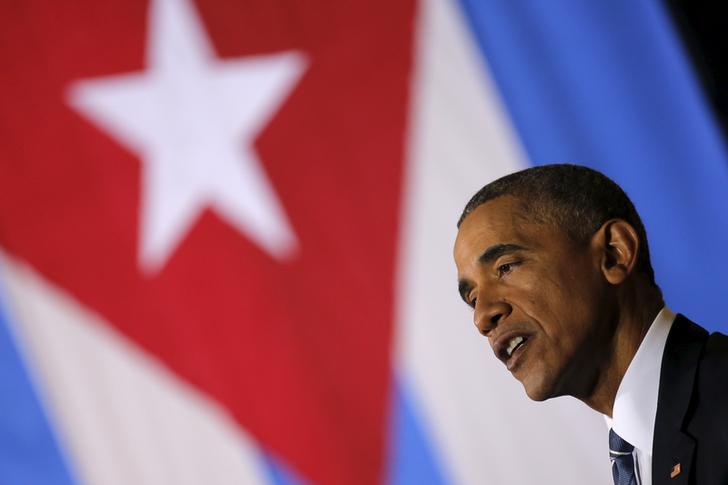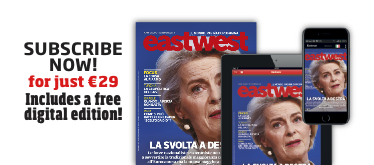The US president Barack Obama began 20 March his official visit in Havana marking a historic turning point in the relations between Cuba and the United States. Tensions between the decade-long enemies sealed the fate of Latin America for more than fifty years, and brought the world to the brink of nuclear war.
It’s been 88 years since an American sitting president last visited the Caribbean neighboring country. That was Calvin Coolidge in 1928 on a destroyer. Obama arrived Sunday in Havana with his family and a large group of MPs and CEOs of some major business groups. A crowd of curious and astonished Cubans full of hope welcomed and cheered him and his family along a relaxed walk in Old Havana admiring the ancient but freshly painted buildings, the music, the colors. On many balconies, unimaginable until recently, the Cuban flag waved next to the Stars and Stripes.
In contrast to the excitement among the people of Cuba and the historical significance much of the world press attached to the event, the main official newspaper of the Cuban Communist Party, Granma, welcomed Obama with a long editorial stating that it was “the first time that a US president arrived in a sovereign Cuba with the Revolution in power” and “not willing to abandon its anti-imperialist ideals”.
While Air Force One was landing, Granma’s website was giving Obama’s visit, which it described as “important” but not as in historical, as much space as to the visit a few days earlier of Nicolás Maduro, the Venezuelan president and last unconditional ally of the Cuban revolution in South America.
Latin American TV stations broadcasted many interviews with Cubans in the street, noting that their takes were all positive. Segundo Alvarez, an aging box trainer said: “If Obama is here, it is badly needed that he improves the conditions of the Cuban people. We resisted and will resist again if necessary, but if things change, we will welcome him with love”. Maryelis Morales, a translator, was gasping for words: “I urge… … whoever we hold most sacred to have the two presidents get along well with each other.”
The contrast between the measured attitude of the Cuban government and that of Cubans in the street hoping for some improvement to their lives, to communications with the rest of the world and to freedom of expression is not the only contrast between what was said and what was done in the process of resuming relations between the two countries that are natural partners by history, geography and culture.
The feeling is that both sides are well aware that there are boundaries that cannot be forced at this time. This includes the embargo and human rights in Cuba, one of the main arguments used against Obama’s rapprochement process by Cuban exiles in the US. In his speech on Monday, the US President acknowledged the differences, and confirmed the commitment to discuss human rights in a future conference .
In recent weeks, raids against dissidents intensified. However, on Sunday, TV cameras from all around the world filmed a demonstration by the Damas de Blanco, the relatives of political prisoners. The same happened at scuffles between the police and some dissidents. In other words, the power of images might succeed where 56 years of harsh policies, especially for the population, did not.
Conservative Cubans in the US, including Sen. Marco Rubio and candidate Ted Cruz, also use against “Cubama” the notion that the United States did actively change many rules and took material steps toward better relations, whereas the Cuban government did not. According to the U.S.-Cuba Trade and Economic Council data, however, this is not true. Cuba took almost as many measures as the US, but it cannot boast about because some sectors within the Cuban society still view these kind of changes with great suspicion.
Behind the scenes, however, the Island is opening up at a pace faster than expected. “These are small but significant steps that make a difference, like agreements for commercial aviation, the postal service or environmental protection. The embargo is important, but these legislative changes opened up many opportunities,” wrote Cuba expert professor and consultant to the US government Bill LeoGrande.
The signed or upcoming agreements between ports (Virginia and Havana), telecommunications infrastructure contracts (AT&T and Verizon, and now Google), ever more commercial flights and the more than 500 North American entrepreneurs visiting Cuba last year confirm that the Island is one of the last frontiers in the world for trade and new production structures. Tourism is progressing at an ever increasing pace: Airbnb leased in the past two months more housing opportunities than throughout the last year, not to mention the big hotel chains that already operative on the Island. Cuba increased the purchase of medicines by 457% compared to 2014.
The forecast for the sugar cane harvest is dismal. While not sounding the fanfare to North American entrepreneurs, the Cuban government is not only opening up to projects, but is also making important concessions: US companies will be able to be direct employers (workers in Cuba are all state employees with some exceptions). Pragmatist Cuban-born entrepreneurs are enthused enthused at the prospect of tackling the new opportunities, like Norwegian Lines’ CEO, who cannot wait to dock in Havana on a cruise ship.
“The difference is that until now Havana confronted the US as such, whereas now it raises specific issues, like the blockade [which only the US Congress can lift, ed], or returning Guantanamo land to Cuba ,” said professor LeoGrande.
“The embargo will end,” Obama stated at the press conference in Havana. He couldn’t predict when, but said that the process will get a boost from the progress being made on a number of smaller issues.
Allowing the one-party government in Cuba to save face – also during the unprecedented Q&A time after the joint press conference on Monday – by not hammering on what is unsolvable in the short-medium term, Obama secured a negotiating partner. In addition, this will help avoid showdowns between the Cuban people and the government, making change more acceptable.
Obama marketed himself well: “He is one of us,” many Cubans of African ancestry proudly said. To everyone’s surprise, the President recorded on Friday a sketch with Pánfilo, Cuba’s favorite comedian. It aired on official TV.
Among the major changes nobody is boasting about is the possibility that the next Party congress will chose Miguel Díaz-Canel, Raul Castro ‘s first vice president, to succeed him. Diaz-Canel is approximately Obama’s age, a Rolling Stones fan, and would be the first non-Castro in power in sixty years.
“Es un nuevo día“, “This Is A New Day”, Obama said. Things are changing in Cuba, albeit slowly and at first unapparent. The opposite of next Friday’s first ever Cuba concert by the Rolling Stones. Entrance is free. These days in Cuba there are historical events for everybody.
It’s been 88 years since an American sitting president last visited the Caribbean neighboring country. That was Calvin Coolidge in 1928 on a destroyer. Obama arrived Sunday in Havana with his family and a large group of MPs and CEOs of some major business groups. A crowd of curious and astonished Cubans full of hope welcomed and cheered him and his family along a relaxed walk in Old Havana admiring the ancient but freshly painted buildings, the music, the colors. On many balconies, unimaginable until recently, the Cuban flag waved next to the Stars and Stripes.





